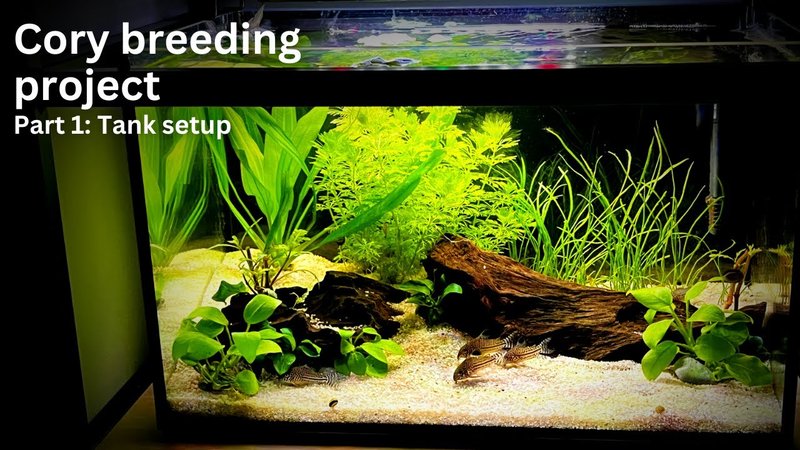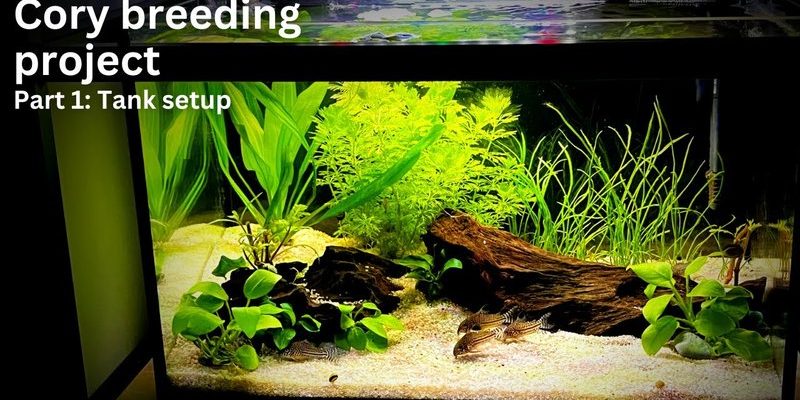
Tank Size: How Much Space Do They Need?
When it comes to tank size, Corydoras catfish are relatively forgiving, but there are some guidelines to keep in mind. Ideally, you should have at least a 20-gallon tank for a small school of these fish. The more space, the better! A larger tank not only provides more room for swimming but also helps maintain stable water conditions, which is crucial for their health.
Here’s the thing: if you decide on a smaller tank, you might find yourself needing to do more frequent water changes—something no fish parent enjoys. A 20-gallon tank is a great starting point for a group of about six Corydoras. You can always expand their home later if you get more fish, but starting with a solid base helps everyone settle in.
Also, consider the overall dimensions of the tank. A longer, wider tank is more beneficial than a tall one. This allows your Corydoras to explore horizontally, as they often prefer to stay closer to the bottom. Think of it like choosing a spacious living room over a tall, cramped attic!
Water Conditions: What Do They Prefer?
Corydoras catfish are quite specific about their water conditions. They thrive in a temperature range of 72°F to 78°F (22°C to 26°C). Maintaining a consistent temperature is essential, as fluctuations can stress them out. You might want to invest in a reliable heater and thermometer to keep things just right.
As for pH, these fish prefer slightly acidic to neutral water, ideally around 6.0 to 7.5. You can use a water testing kit to measure these levels regularly. Here’s a tip: if you find the pH is too high or low, there are plenty of natural methods to adjust it. For example, adding driftwood or almond leaves can help lower pH naturally while adding a nice aesthetic to the tank.
Lastly, don’t forget to consider the water hardness, which should be between 2-12 dGH. Soft water is preferred, as hard water can lead to health issues over time. Regular water changes, about 10-15% weekly, can help keep the conditions stable. It’s like setting a little routine that keeps your fish healthy and happy.
Substrate: The Best Bottom for Corydoras
Corydoras catfish are natural bottom dwellers, so choosing the right substrate is important. They enjoy soft, sandy bottoms because it’s gentle on their delicate barbels—the little feelers on their faces. Sharp or rough substrates can injure them over time. So, think of your tank’s bottom surface as the floor of a cozy home; you wouldn’t want to walk on something uncomfortable!
A fine sand substrate is ideal and allows these fish to dig and scavenge naturally. You might also want to mix in some smooth pebbles or gravel. Just make sure any rocks you use are rounded; sharp edges can be a disaster waiting to happen.
Another option is to create a layered effect. Place sand on the bottom, and gently sprinkle gravel over it. This way, your Corydoras can enjoy the benefits of both options. Plus, it adds a nice visual element to your tank!
Décor: Creating a Cozy Environment
When decorating the tank, think about adding structures that mimic natural habitats. Corydoras love to hide and explore, so providing plenty of hiding spots will keep them happy. You can use driftwood, rocks, and live plants to create this kind of environment.
Live plants are a great addition, not just for aesthetics but also for providing oxygen and improving water quality. Plants like java fern and anubias are hardy and can thrive in a variety of conditions. They also offer cover for your fish, allowing them to feel safe and secure.
You can also add caves or tunnels where your Corydoras can retreat. Clay pots turned on their sides or store-bought aquarium caves work well. Just ensure that anything you put in the tank is aquarium-safe and won’t leach harmful chemicals. Creating a cozy space is all about balance; it should feel like a little underwater oasis for your fish.
Tank Mates: Who Can Live with Corydoras?
Corydoras catfish are generally peaceful and social fish, which makes them great additions to community tanks. But you might be wondering, “What other fish can I house with them?” Ideally, you want fish that are similarly sized and share the same water requirements.
Some excellent tank mates include tetras, guppies, and rasboras. These fish are friendly and won’t bully your Corydoras. Avoid larger or aggressive species that may see your catfish as snacks or harass them.
If you’re aiming for a diverse community tank, stick to peaceful fish that swim at different levels. This way, everyone in your tank has their own space and can interact without stress. Remember, harmony is key!
Feeding: What Do Corydoras Catfish Eat?
Feeding Corydoras catfish is an enjoyable task because they’ll eat almost anything! They’re scavengers by nature, so offering a varied diet will keep them healthy. High-quality pellets designed for bottom feeders are a great staple. But here’s the thing: they have a bit of a sweet tooth!
Adding frozen or freeze-dried foods like bloodworms, brine shrimp, or daphnia can spice up their diet. You can also give them blanched vegetables, such as zucchini or peas, which they’ll appreciate. Just make sure to remove anything uneaten after a few hours to keep the tank clean.
Keep an eye on their feeding habits and adjust amounts as necessary to prevent overfeeding. You wouldn’t want to throw a party and have too much leftover food, right? The same goes for your fish tank!
Regular Maintenance: Keeping the Tank Healthy
Maintaining a clean and healthy tank is essential for the well-being of your Corydoras catfish. Regular cleaning involves changing a portion of the water, cleaning the substrate, and checking equipment like filters and heaters.
You should aim for a weekly water change of about 10-15%. This helps keep the water parameters stable and reduces harmful toxins. When you do this, it’s best to use a gravel vacuum to clean the bottom without disturbing the fish too much.
Don’t forget to perform regular checks on your filtration system! Ensure it’s functioning well and that you’re replacing filter media as needed. It’s like giving your fish their very own spa day, keeping everything fresh and flowing smoothly.
In conclusion, setting up the ideal tank for Corydoras catfish is straightforward, but it requires some thought and attention to detail. With the right size tank, proper water conditions, and cozy décor, you’ll create a happy home for your little friends. Remember, the more you understand and cater to their needs, the more vibrant and lively your aquarium will be. Enjoy the process, and happy fishkeeping!

